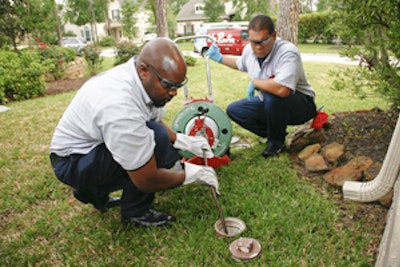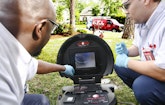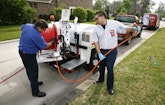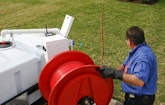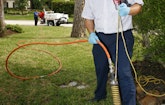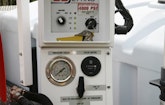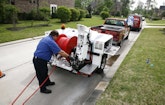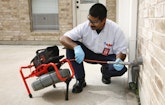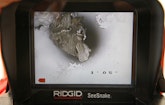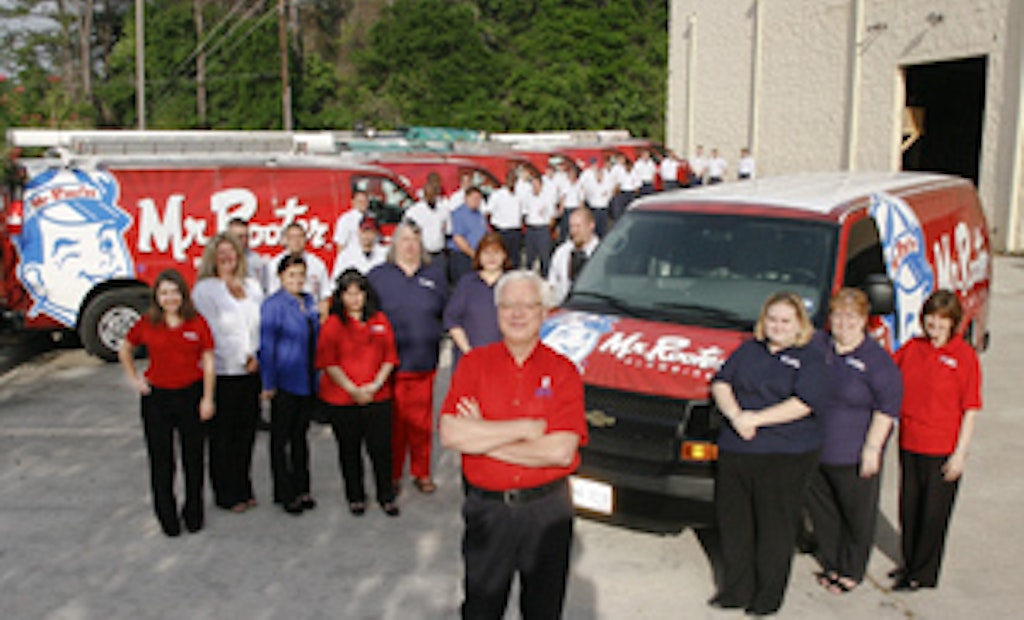Interested in Plumbing?
Get Plumbing articles, news and videos right in your inbox! Sign up now.
Plumbing + Get AlertsWith a detailed business plan in hand, Roger Goertz and his wife Stacey purchased an existing Mr. Rooter franchise in Houston, Texas, in August 2003.
The company covered two counties and had five technicians and five service vans on the road. By the time 2012 rolled in just shy of eight years later, the company had grown impressively to 20 technicians and 20 service vans, plus five excavation vehicles. They had also added another county to their service area and established a broadly expanded and realigned customer base.
“Our business plan detailed the first seven years and what we had forecast,” says Goertz. “We actually exceeded those sales within our first four years.”
He says one of the initial steps was working with the existing plumbers and getting them to understand his business philosophy of conveying a more empathetic attitude toward the residential customer – to be not just a plumber who walks in to fix a problem, but to relate better as technicians, explain the available options, and treat the customer with a greater degree of respect. Goertz wants his people to ask questions so they can diagnose and resolve problems for customers.
Restructuring the base of the operation was another important measure.
“At least 80 percent of the business with the previous owner was warranty work with manufacturers and installations with home improvement stores,” says Goertz. “We wanted to align ourselves more with service and repair of plumbing problems for the residential customer.
“We placed ads in the telephone books for the areas we covered. We also did a mailing to all customers serviced over the previous 12 months for warranty work, introducing ourselves and offering a $25 gift card and describing our expanded services.”
Goertz saw jetting as an opportunity for growth, and within four months of purchasing his Mr. Rooter franchise he purchased a trailer jetter from US Jetting LLC and began promoting this option to solve drain problems. They currently use a 2011 US Jetting 4018-300 trailer jetter with 500 feet of 1/2-inch hose on a 180-degree pivoting hose reel. They use US Jetting stainless Penetrator and stainless Flusher nozzles, and the Egghead Push nozzle.
“We felt this was an important step to add because cabling does not remove all debris, grease and buildup in the line,” says Goertz. “Cabling does not remove all roots, which become very soft, very fibrous. When the cable and blades go through the line in a circular motion it just won’t cut all the roots.”
When talking with customers about jetting a line, Goertz likes to compare it to a jar of peanut butter.
“If a person tries to remove all the peanut butter from a jar with a spoon, you just won’t get it all,” he says. “You need to use a spatula. In a drain line, the jetter goes through and acts like a spatula in cleaning the line.”
He says the residential customers don’t always understand the benefits of using a jetter to clear a line, but the peanut butter analogy provides some understanding. Between 10 and 15 percent of their drain cleaning calls lead to jetter service. Customers who want a line jetted get a three-year warranty on that line.
All technicians are trained on using the jetter, but Goertz has one technician, William Corder, who is considered the master jetter. He knows the equipment and how it functions in all respects. When a technician sells a jetting job, a phone call goes to Corder, who will then transport the jetter to the site. The original technician, who has developed the rapport with the customer, stays on site and will do any small chores the homeowner might require, at no charge, until the unit arrives. This might be as simple as replacing a light bulb for an elderly lady, or tightening a toilet seat. Or he can offer to do an inspection of the entire house.
With the jetter on site, Corder acts as an assistant to the selling technician. This is important because it honors the relationship the technician and customer have developed.
Goertz says the advantage of the jetter is that it has many functions and multiple hose sizes and fittings, and can go from a 1- to 1 1/2-inch line up to a 6- to 8-inch-diameter line.
Fitness through training
In addition to on-site training with US Jetting, Goertz has some internal procedures and exercises he conducts to be sure technicians are well schooled in all aspects of jetting. Safety measures are strictly adhered to. Safety glasses, gloves and proper footwear are always required.
“You have to keep in mind that this can operate up to 4,000 psi,” says Goertz. “The first 10 feet of hose, the leader hose, is a different color. That separate 10-foot section that screws on the end of a 500-foot hose is there for a reason. That is the safety hose. If the sewer line is 50 or 60 feet, you have that hose all the way in and when you start pulling it back, you know when you are at the last 10 feet. That is a safety feature.”
Goertz notes that jetting has been especially important to their growth when dealing with areas where there are yard drains, which frequently build up with dirt, soot and twigs.
A camera to the rescue
Having a camera on every van has also been a boost for customer service, notes Goertz. This Mr. Rooter offers the service at no extra charge if the line has been cabled. Technicians don’t need to go back to headquarters to pick up cameras because the equipment is readily available. Each technician is well trained on the operation and care of the camera because of the heavy investment required.
Presently, they have 14 RIDGID SeeSnake compact cameras and six Spartan Tool color compact sewer pipe inspection cameras. They also have 11 Spartan 415R locators.
Always at the ready
The fleet of 20 Chevrolet 3500 Express Cargo vans (3/4 to 1 ton) range from 2007 up to six 2012s they took possession of in January. Goertz leases his vehicles, so they are never more than four years old. He has a buyout option at the end of a three-year lease. High mileage vans are sold, but Goertz keeps vehicles with low mileage for use as excavation vans to deliver replacement pipe and tools for sewer, gas and waterlines. Because sewer lines are not deeply buried – usually 2 to 2 1/2 feet – most projects call for hand digging, but he does have one Kubota KX 413 V and a total of six excavation vans. Six employees work at excavation and they usually have from three to six excavation jobs going on at any one time.
The Kubota is used when they are tunneling under a home and they have to dig a fairly large access hole, sometimes four feet wide and four feet long.
Goertz says technicians take their vehicles home each evening and are dispatched from their location. Everyone comes into headquarters for a company meeting every Tuesday morning.
Getting the right start
Having all the technicians on the same page and in the company program starts with hiring and training apprentices. Goertz selects beginners to join the company and learn the programs and the trade 75 percent of the time.
Training is conducted by Goertz to some extent, and also by four journeymen and one master plumber at the office. Technical training takes place in the field, riding with one of the licensed plumbers for nine months to a year and a half. In most cases, a candidate will ride with at least three different technicians to gain a well-rounded experience. Currently there are seven apprentices in the program.
In the hiring process, Goertz will conduct the initial interview after the candidate fills out an application. He will spend no less than 30 minutes, and he is not looking for technical skills, but rather as much about the potential employee as possible – background information and interests. He also shares information about potential earning possibilities. Following the interview, he will check references and if he is interested he will invite the candidate back for another discussion.
“Stacey and I have viewed our company as a family, and we are looking for employees who will be a part of our corporate family structure,” he says.
Goertz has several office departments that report directly to him. In the field he has three field manager senior technicians. One is a master plumber and two are journeymen. They each have five or six technicians assigned to them in teams dubbed the Red, White and Blue. This is designed to create some competition within the company.
Stacey Goertz was instrumental in finding a home base for the business, which occupies 10,000 square feet of office and warehouse space on a 1.8-acre lot in Spring, Texas, a suburb of Houston. The couple also formed another company that shares this property. Rainbow International deals with water, fire, smoke damage and restoration.
Summing up the rewards
In reflecting on the effort that went into building the business, Goertz says his primary satisfaction has come from putting the principles he preaches into practice. After all those years of teaching others how to run and grow a business, he has had the opportunity to put all those thoughts, policies and procedures, as well as his own efforts and money, into his own business.
“You have to have systems in place,” he says. “You have to have a process where if one person leaves, another can step in and pick up the pace professionally and keep things going. Stacey and I were able to take a concept and prove to ourselves and to others the value of a corporate structure and that expertise, and how it pays off and grows in many directions. Very satisfying.”
